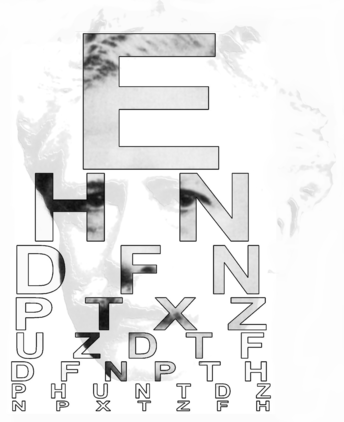Herman Snellen1834–1908
Snellen transformed the manner in which visual resolution is assessed. In contrast to previous methods of measuring acuity, which varied the distance of viewing a constant stimulus, he varied the sizes of stimuli. He developed a test, using letters of different dimensions, that was and still is widely used by opticians to determine the strength of optical corrections for short and long sightedness. He is barely discernable within letters from a modified chart for determining visual acuity. Earlier students of visual resolution, like Hooke and Daça de Valdes, used of dots, lines, gratings and grids but these were not seriously pursued by clinicians, partly because of the inconvenience of varying the distance of observation for fixed stimuli. They adopted the alternative approach of viewing stimuli of variable size at a fixed or short range of distances. Text was a convenient stimulus and the ability to read it was employed as a rough index of acuity. In the nineteenth century letter shapes and sizes were examined more systematically because typefaces could be varied in size with ease and could be readily reproduced, unlike gratings and grids. Presenting type of different sizes obviated the need to vary viewing distance alone and was more appropriate for clinical examination. In 1844, letter shapes were produced by Heinrich Küchler (1811-1873), but they were extended with great precision and standardized by Eduard Jaeger (1818-1884) a decade later. His test-types were based on the assumption that acuity was essential for reading and that an adequate test would involve letter sequences; Jaeger also developed a test with vertical lines of decreasing width. An alternative approach was pursued by Snellen in 1862: he devised geometrical shapes of differing size and orientation and also letters of particular configurations. Under the guidance of Donders at Utrecht, a functional test of acuity was developed. Donders introduced the term ‘visual acuity’ for what had previously been described as the ‘minimum visible or separable’, and he was quick to apply the new method for assessing acuity in his own studies of declining acuity with age. In addition to using a variety of letters, Snellen (1882) used a single, well-defined E in different sizes and orientations, so that any patient could perform the task. Snellen’s isolated shapes were called optotypes, but it is his letter chart that has stood the test of time.
